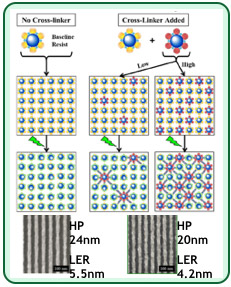
Scientific Achievement
Users from Intel collaborated with staff from the Molecular Foundry and the ALS to create a new approach to photoresist that achieves both high-resolution and sensitivity.
Significance and Impact
Current photoresist designs have a tradeoff between resolution and sensitivity but this approach could lead to resists capable of patterning features at the molecular level with high sensitivity.
Research Details
- Cross-linking resists have good mechanical stability and do not distort during development, leading to good resolution (measured by half-pitch resolution (HP)), but suffer from poor sensitivity.
- Chemically amplified resists generate an acid catalyst that enhances sensitivity but degrades resolution and increases line edge roughness (LER).
- Industry users working at the Molecular Foundry combined the best of both worlds with a new small molecule resist matrix, which uses chemically amplified deprotection, and adding a dilute cross-linker.
- Extreme UV from the ALS was used to expose the new resist and demonstrate the superior performance (HP, LER) shown in the figure.

